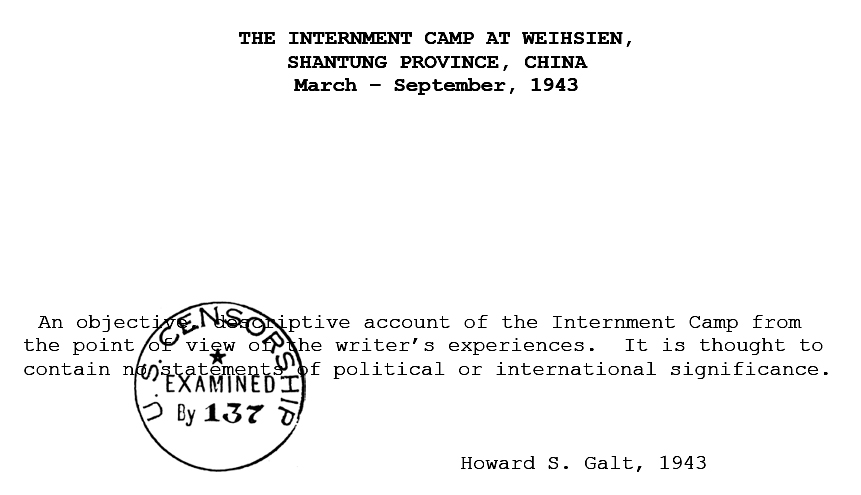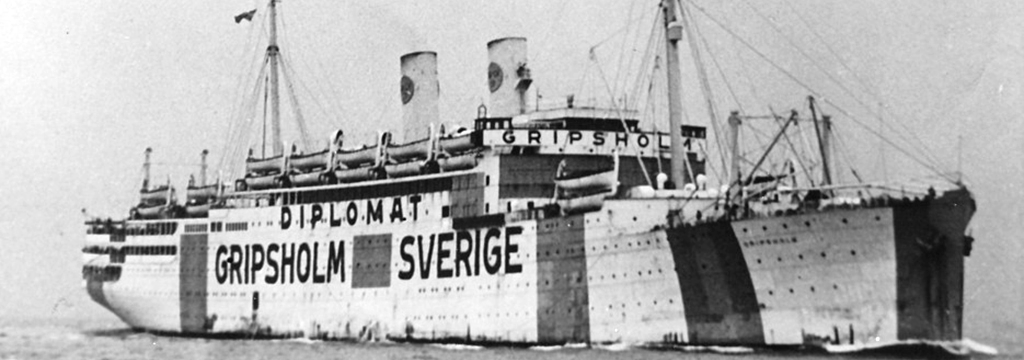
by Howard S. Galt
[excerpts] ...
[...]
 After the camp residents had all arrived, and provisions had been made for living quarters and eating arrangements, it was time for the permanent organization of camp life and activities. We had been informed in advance that the camp must be self-operating as far as labor was concerned – that no servants or workmen would be supplied to us, and that the work must thereafter all be done by ourselves.
After the camp residents had all arrived, and provisions had been made for living quarters and eating arrangements, it was time for the permanent organization of camp life and activities. We had been informed in advance that the camp must be self-operating as far as labor was concerned – that no servants or workmen would be supplied to us, and that the work must thereafter all be done by ourselves.
But organization included much besides labor activities. Recreational, cultural, educational, musical, religious, and other activities and interests were all promoted and regulated by the general organization.
[excerpts] ...

The Employment Committee
In charge of the permanent and periodic assignment of work jobs.
The scope and importance of this committee’s functions will be readily understood.
Its decisions and appointments affected the daily work of more than 1,000 people - all of the adults and many of the older children. Of course there was much labor connected with the commissariats of all three kitchen groups.
Accordingly there were three subcommittees to take charge of these divisional assignments.
Taking the Peking (Kitchen 3) group as an example: The committee instituted an inquiry of all concerned to discuss the qualifications, aptitudes, skills, and preferences with respect to the great variety of tasks to be done. In the assignments special skills, aptitudes and choices were considered as far as possible.
Some skills and aptitudes – for example those of amateur carpenters – suggested permanent assignments to jobs.
In types of work perhaps not requiring much skill, or which were particularly hard and unpleasant, frequent rotation was most satisfactory.
The week was chosen as the unit of time and so it came about that there was posted a weekly bulletin giving a complete list of assignments to tasks for the following week. These weekly lists probably contained the names of at least 100 people.
Of kitchen and dining room activities more will be written below. Besides the work in the three kitchen groups there were general tasks by which the whole camp was served.
There was the central bakery, which operated more than half of the 24 hours of each day, thus requiring several shifts of workers.
There were the pumps which supplied water to the reservoir tanks, and which had to be manned steadily all day long.
There were the furnaces and boilers for the supply of hot water for the bath showers and for washing purposes, and distilled water for drinking. These required men with engineering experience.
There were the sanitary installations to be cared for – work the more necessary and the more unpleasant because of the defects of the plumbing system.
There were jobs for carpenters, blacksmiths, plumbers, metal workers, masons, and electricians. To these jobs there were usually permanent assignments as mentioned above.
[excerpts]
Committee on Engineering and Repairs
This committee was under the direction of a trained engineer.
In cooperation with the employment committee there were organized squads of masons, electricians, plumbers, metal-workers and carpenters. Some of the work of these specialists consisted of repairs, but much of it was of the nature of remodeling or rebuilding to remedy deficiencies in the original preparation of the camp. Some of the men among these skilled workers were men of special training in these vocations, but most of them were men whose avocations had attracted them into these fields and whose skills were those of amateurs.
In the fields of women’s work there was some unofficial but very effective organization.
A few sewing machines were available and so a center for sewing and repair of clothing was established.
Repairs of course implied chiefly hard work, and this was distributed among a large number of women to be done in their homes.
As to laundry work, most people did their own, often in the midst of great difficulties and limitations. Washing was of course a necessity but many came to the conclusion that ironing was an unnecessary (or unobtainable) luxury. In the laundry work many women helped their men friends in voluntary and informal ways.
However, a group of Catholic Sisters, taking advantage of facilities in the Hospital basement, organized a semi-public laundry, and eventually arrangements were made by them with skilled Chinese in a village outside to do laundry work on a commercial basis.
One enterprising woman widely known and experienced in the management of a shop in Peking, took the initiative in establishing camp exchange (known as the “White Elephant Exchange”) where, besides some buying and selling, people could exchange their own useless things for things useless to other people – a process of transformation which rendered all things useful.
This institution was not fully organized for several months, but when it was installed in its own quarters and clearly advertised, it rendered much service to the community.
Other aspects of women’s work will be described below in connection with kitchen and dining room service.
There were three other forms of community service not mentioned in what we have reported about organization and employment.
A barber shop was manifestly a great need and, when two men with the necessary skills were found, a room was provided and the shop opened.
Shoe repairing was a second need soon widely felt, since the foot wear was deteriorating with the heavy work and a shoe-repair shop was opened.
A third need was watch repairing. Several decades earlier the Catholics gained the reputation of introducing the arts of watch and clock repairing into China, so it was not surprising to find among our Catholic Fathers a man with skill in this art – whereupon a shop for his services was duly opened.
Thus, sooner or later, as almost all the practical needs of a community of 2,000 people became evident, ways of supplying these needs were found and adopted, so it might almost be said that our camp was a self-contained community.

[further reading],
http://www.weihsien-paintings.org/DonMenzi/ScrapBook/1943-03to09-TheInternementCampAtWeiHsien.pdf
#








